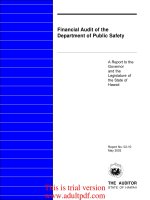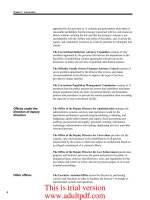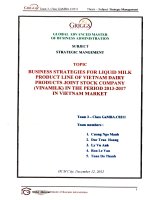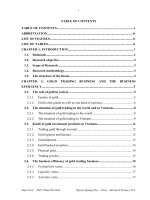A REPORT ABOUT THE PERFORMANCE AND VALUATION OF VIETNAM DAIRY PRODUCTS JOINT STOCK COMPANY
Bạn đang xem bản rút gọn của tài liệu. Xem và tải ngay bản đầy đủ của tài liệu tại đây (387.25 KB, 19 trang )
HANOI UNIVERSITY
FALCUTY OF MANAGEMENT AND TOURISM
A REPORT ABOUT THE PERFORMANCE AND
VALUATION OF VIETNAM DAIRY PRODUCTS JOINT
STOCK COMPANY
Lecturer: Mr. Nguyễn Xuân Trường
Tutor: Ms. Nguyễn Thị Vân Anh
Group: 01
Students: Viêm Thị Anh – 1904040010
Đào Thị Dung – 1904040022
Phạm Ngọc Huyền – 1904010044
Trần Ngọc Mai – 1904040075
Nguyễn Thị Thảo Vân - 1904040125
Tutorial Class: 02
Tutorial Time: Monday afternoon, 14h30 – 16h10
Subject: Financial Management
Date: May 7th, 2021.
i
TABLE OF CONTENTS
EXECUTIVE SUMMARY.................................................................................................................iv
1. Introduction......................................................................................................................................1
1.1.
General information.............................................................................................................1
1.2.
Main business activities........................................................................................................1
1.3.
General stock information...................................................................................................2
2. Main Body.........................................................................................................................................2
2.1.
Financial Statement Analysis...............................................................................................2
a)
Financial Statement Information..........................................................................................2
b)
Financial Ratios....................................................................................................................3
c)
Trend Analysis.......................................................................................................................4
d)
Comparative Analysis............................................................................................................6
e)
Dupont Analysis.....................................................................................................................7
f)
Strengths and Weaknesses of Vinamilk.................................................................................7
2.2.
Valuation...............................................................................................................................8
2.2.1.
Firm Valuation...............................................................................................................8
2.2.2.
Intrinsic Value of Stock.................................................................................................9
2.2.3.
Recommendation...........................................................................................................9
3. Conclusion......................................................................................................................................... 9
REFERENCES.................................................................................................................................11
APPENDIX A.....................................................................................................................................13
APPENDIX B.....................................................................................................................................14
ii
TABLE OF TABLES
Table 1: Brief financial statement of Vinamilk as at 31 Dec 2020.............................................3
Table 2: Financial Ratios of VNM over the period 2016-2020..................................................5
Table 3: Financial ratios of Vinamilk in comparison with the dairy industry in 2020...............6
Table 4: Calculation of Vinamilk ROE using Dupont equation (2016-2020)............................7
Table 5: Expected free cash flow for the 12-year period from 2020 to 2032............................8
iii
EXECUTIVE SUMMARY
Vietnam Dairy Products Joint Stock Company (Vinamilk) is the most dominant
manufacturer and trader of milk, dairy products as well as related equipment in
Vietnam. Being the enterprise that consecutively leads the dairy products market
with diverse products for the national economic life in recent years, Vinamilk has
made outstanding growth steps, contributing positively to the development of the
dairy product industry. In the Vietnamese market, Vinamilk always maintains its
position as the best dairy brand and is normally chosen by Vietnamese consumers
to purchase for 8 continuous years. To obtain these achievements, the company has
had effective plans that are directly related to the financial firm and financial
market. Firm performance is distinctly illustrated in its financial statements
especially through intrinsic value of stock. Therefore, the following study is
conducted based on these findings about Vinamilk’s financial information in order
to analyze its performance by indicating ratio analysis and estimate the value of
this company through using many financial tools and models learned in the
Financial Management subject. As a result, we have shown the advantages and
drawbacks of the financial firm situation. Some recommendations are
simultaneously given in this paper with the hope to decide the correct stock price
of its firm for investors.
iv
1. Introduction
1.1.
General information
“Vietnam Dairy Products Joint Stock Company” is abbreviated to “Vinamilk”, known
as the leading enterprise in the dairy processing industry, currently accounting for 75% of the
market share of milk in Viet Nam. Vinamilk was founded in 1976 as a State-owned enterprise
and later formally modified into a joint-stock company in November 2003. In addition,
Vinamilk has been enumerated on the Ho Chi Minh Stock Exchange (HOSE) since January
2006 along with the trading code, VNM. Vinamilk is headquartered in District 7, Ho Chi
Minh City with numerous branches and factories covering 64 provinces and cities in Viet
Nam.
1.2.
Main business activities
Vinamilk is the best dairy product manufacturer in Viet Nam with a large number of
revenue and outputs in the market. Vinamilk is trusted by a lot of consumers in the market
because it does not only provide the advanced products but also ensure the nutritional value of
products. Vinamilk’s product portfolio includes: essential products are milk and powdered
milk, yogurt, drink, ice cream, cheese and other products of milk. The outputs are provided by
Vinamilk with an impressive list of products, flavors and packaging which are produced with
advanced technology and high quality of farms in Viet Nam. There are more than 200 types of
products launched to the market by Vinamilk and conformed to the strict regulation of
processing. Moreover, Vinamilk is also the leading enterprise in the dairy industry which has
domestically a large-scale product distribution network with 183 distributors and nearly
94,000 points of sale in specialized stores of Viet Nam. Despite being a well-known brand in
Viet Nam, Vinamilk is constantly developing its quality products so as to export to many strict
markets such as European & the US.
Besides, Vinamilk is known as a remarkable trader in the market about technology,
equipment and materials for producing food. Vinamilk has built 13 factories and 13 farms
which applied advanced technologies in breeding and managed following European standards.
With a lot of experiences in food operation factories, Vinamilk confidently prepares the
quality production process and supplies to the raw material market.
Furthermore, one of the main business activities of Vinamilk is house trading, real
estate and transaction intermediation in real estate. Vinamilk is a reliable selection in the
services of warehouse and delivery products as well as transportation.
1
1.3.
General stock information
In the market share and production capacity, Vinamilk has the admirable position by
dint of possessing the system of mega factories with the huge distribution networks. In spite
of the impacts of the pandemic, Vinamilk also has continuously achieved more market share
with the certain plans of its company. The company’s market share maintained at 61% at the
end of 2019. The total charter capital of Vinamilk is 17,416,878 million VND until 2020 and
the par value of common stock is 10,000 VND. The number of outstanding shares is
2,089,955,445. The market price of Vinamilk’s stock is 108,900 VND as of December 2020.
2. Main Body
2.1.
Financial Statement Analysis
a) Financial Statement Information
In fact, financial statements are essential because it consists of all significant financial
information of a company, identifying the strengths and weaknesses of the firm by creating
the relationship between the balance sheet and income statement and reflecting the financial
position of that firm. From that, we can calculate financial ratios, and stakeholders can based
on that information to evaluate and make suitable economic decisions on their own.
Some financial accounts which is used to calculate financial ratios and evaluate the
strengths and weaknesses of Vinamilk in 2020 is shown in the table as below:
Balance Sheet
Total Assets
48,432,480
Current Assets
29,665,726
Fixed Assets
13,853,807
Inventories
4,905,069
Account Receivables
5,007,227
Total Liabilities
14,785,358
Current Liabilities
14,212,646
Notes Payable
7,483,918
Owner’s Equity
33,647,122
Income Statement
Sales
59,722,908
Net Income
11,235,732
EBIT
13,683,198
Ratio
EPS ( Earnings Per Share)
0.00477
Table 1: Brief financial statement of Vinamilk as at 31 Dec 2020 (million dong)
b) Financial Ratios
Liquidity Ratio
2
Liquidity, including current ratio and quick ratio, reflects the power of Vinamilk to
fulfill its short-term obligations using assets that are most readily converted into cash.
The current ratio is the ratio of current assets to current liabilities point out the
company’s ability to respond to its current liabilities with its current assets. As calculated
shown in Table 2, the current ratio of Vinamilk is around 1.74, showing that Vinamilk has the
ability to cover its short-term liabilities by its short-term assets.
The quick ratio is the ratio of current assets less inventory to current liabilities point
out the company's ability to respond to current liabilities with its most liquid assets. As shown
in Table 2, the quick ratio 2020 of Vinamilk is nearly 2.08, it is a quite good number for
Vinamilk.
Asset Management Ratio
Asset management measures how the firm uses its assets efficiently. There are three
types of asset management ratio: Inventory turnover, day sales outstanding (DSO), Fixed
assets turnover (FA turnover) and Total assets turnover (TA turnover).
Inventory turnover measures the flow of goods in the form of inventory over a year.
The higher the inventory turnover, the business will sell fast, which means if the inventory
time is lower, the business will sell slowly and more inventory. Vinamilk's inventories in 2020
is 12.17 proved that Vinamilk is selling faster and having less inventory.
Days sales outstanding measures how fast or slow charge is when using credit sales
methods (commercial credit). The DSO of vinamilk in 2020 is 31.82, tending to increase. It
can cause serious cash flow problems.
FA turnover and TA turnover of Vinamilk in 2020 are 4.31 and 1.23. It can be seen that
asset turnover is higher than 1 so this equivalent with the sales of Vinamilk Company is
greater than the total asset and the enterprise's ability to manage assets increases, inventories
flow quickly, accounts receivable are receivable faster, which is very convenient for the
company's business.
Debt Management Ratio
In corporate finance, the degree to which debt is used to finance a company's
operations is known as financial leverage. Financial leverage has two aspects: Increases
profits or Increases risks for the company. So, debt management is just as important as asset
management.
The debt to total asset ratio, commonly known as the debt ratio, measures how well
the company uses its debt to its assets. We can see the debt ratio of Vinamilk in 2020 stay at
the level of 0.30.
3
TIE measures a company's ability to pay interest. The company's ability to pay interest
is high or low, depending on its profitability and its use of debt. Times interest earned of
Vinamilk in 2020 is 94.14. It can be seen that Vinamilk's ability to pay interest is quite large.
For businesses, the ultimate goal is profit. Profit is a general financial indicator
reflecting the efficiency of the entire investment, production, consumption and technical
solutions, economic management at the enterprise.
Operating profit margin measures the ratio of earnings before interest and tax to its
sales. Operating profit margin of Vinamilk in 2020 is 0.22 reflecting the performance of the
company.
By profit margin ratio, the return on revenue ratio is 18% in 2020, which means that
for every 100 VND of revenue, 18 VND of net profit will be generated.
By basic earning power (BEP), the base return is 27% in 2020, which means that one
coin spent will yield 27 VND of profit.
By return on total assets, 100 VND in assets by 2020 will generate 23 VND of net
profit.
By return on common equity, for every 100 VND of capital spent by common
shareholders in 2020, 33 VND of net profit will be generated.
Market Value Ratio
Market value brings in the stock price and helps investors think about the firm. Price
to earnings ratio is the relationship between the current price of a security and the ratio of
earnings per share. A low P/E ratio means the higher the company's return on a share, or lower
the stock's market value.
To see if Vinamilk's P / E ratio in 2020 is high or low, investors need to consider P / E
of many years ago, or compare P / E of this company with other companies in the same
industry or in the same industry economy. In general, Vinamilk's P / E ratio in 2020 (22.80) is
relatively high.
c) Trend Analysis
Ratio
Ratio
Formula
2016
2017
2018
2019
2020
Current ratio
2.19
1.59
1.41
1.36
1.74
Quick ratio
2.89
1.99
1.93
1.71
2.08
Inventory
turnover
10.38
12.71
9.52
11.31
12.17
4
DSO
22.44
33.15
32.78
29.27
31.82
5.64
4.81
3.93
3.78
4.31
TA turnover
1.59
1.47
1.40
1.26
1.23
Debt ratio
0.23
0.31
0.29
0.33
0.30
TIE
240.0
1
416.3
2
231.2
0
118.5
9
95.14
Operating
profit margin
0.23
0.23
0.22
0.22
0.22
Profit margin
0.19
0.20
0.19
0.18
0.18
BEP
0.37
0.35
0.31
0.28
0.27
ROA
0.31
0.29
0.27
0.23
0.23
ROE
0.41
0.43
0.38
0.35
0.33
P/E
21.54
32.82
22.66
21.26
22.80
FA turnover
Table 2: Financial Ratios of VNM over the period 2016-2020.
Liquidity
It can be seen that solvency coefficients from 2016 to 2020 are larger than 1, proving
that short-term assets, short-term investments... are able to offset the debts when incurred.
Thus, this created crucial advantage in raising capital for business activities further as
increased credibility for suppliers of the corporate.
Asset Management
We can see that Vinamilk's inventories from 2016 to 2020 are getting higher from
10.38 to 12.17. It proves that Vinamilk is growing more and more, selling faster and having
less inventory. Asset turnover of Vinamilk from 2016-2020 is higher than 1 so this equivalent
with the sales of Vinamilk Company is greater than the total asset. Therefore, Vinamilk is
using its assets efficiently. However, this tends to decrease during 5 years together with the
increase in Day’s sales in receivable so that this company may have some troubles in the
quantity of sale or the increasing in investors combined with the remain stable in sales.
Debt Management
In debt ratio, creditors often want the company to have a low debt ratio so that the
company can better repay the debt. In contrast, shareholders often want a high debt ratio
5
because the use of financial leverage increases profitability for shareholders. However, if you
want to know whether the debt ratio is high or low, you need to compare it with the debt ratio
of the industry average. The debt ratios over the years tend to stabilize at the level of below
35%.
In TIE, the use of debt generates profits for the company, but shareholders only benefit
when the profits generated are greater than the interest paid for the use of debt. The greater
the EBIT than the interest, the more likely it is to secure the payments of interest from the
guaranteed profit. The TIE ratio over the years tend to decrease shown lower ability to pay
interest.
Profitability
We can see that the operating profit margin and profit margin over 5 years to stabilize
at the level of below 22% and 18%. In 2016, the base return was 37%, which means that one
coin spent would yield 37 VND of profit. In 2017-2020, one coin of assets spent brings 3531-28-27 VND of profit. It can be seen that Vinamilk's underlying profitability declines due to
the decline in net profit from operating activities and decline in revenue. In addition, the
return on equity and the return on assets of Vinamilk have also decreased over time.
Market Value
As shown in the table above, it can be clearly seen that the P/E of Vinamilk fluctuates
over the time period from 2016 to 2020. It is due to the change in the firm’s activities over
year, but it still quite high in the whole.
d) Comparative Analysis
Ratio
Current Ratio
Quick Ratio
Inventory Turnover
Profit Margin
ROA
ROE
P/E
VNM
1.74
2.08
12.17
18.81
23.20
33.39
22.81
Industry
2.03
2.63
6.23
19.52
22.47
28.27
22.16
Comment
Low
Low
High
Low
High
High
High
Table 3: Financial ratios of Vinamilk in comparison with the dairy industry in 2020 (%).
e) Dupont Analysis
2016
2017
2018
2019
2020
ROE
0.4179
0.4305
0.3885
0.3550
0.3339
ROE (%)
41.79%
43.05%
38.85%
35.50%
33.39%
Table 4: Calculation of Vinamilk ROE using Dupont equation (2016-2020)
6
Despite fluctuations, the returns on Vinamilk’s equity is generally showing a
downward trend in 2016-2020. Looking at the details, the percentage of ROE started at
41.79% in 2016 and then increased slightly at 43.05% in 2017. However, the percentage of
ROE following DuPont gradually decreased from 2017 to 2020. In 2018, the ROE index was
38.85%; by 2019, the percentage of the dupont equation had dropped to 35.50% and then
reached its lowest level in 2020 at 33.39%. The variation of return on equity followed DuPont
depends on three factors: profit margin, total asset turnover and equity multiplier. Therefore,
the decrease in ROE’s Vinamilk is due to net profit margin decreasing gradually, asset
turnover did not improve and gradually increased financial leverage.
f) Strengths and Weaknesses of Vinamilk
Strengths
Firstly, Vinamilk is the leading enterprise in Vietnam dairy industry, is the trustworthy
brand name in domestic market .Up to now, Vinamilk has 12 factories during which there are
two biggest factories in Asia and all factories are supplied high-technology with international
criteria in manufacturing process. Therefore, Vinamilk can take the advantage both in high
volume and quality’s products against other competitors.
Secondly, VNM has wide marketing channel, retailers and supply their products to the
supermarket throughout Vietnam, so Vinamilk products can be easy to approach to the users.
Thirdly, VNM has a good strategy to manage the expenditure to share the price’s
burden to the consumer and also get more profit generated from sales.
Lastly, VNM invests mainly in both fresh and processed dairy products, to create
many choices for consumers. Recently, Vinamilk added more products like probeauty yogurt,
soya milk, Dielac formula powder milk and so on to make products satisfy the needs of all
people.
Weaknesses
First, the imported dairy material constituted quite 70% so it is suffering from the
changing in price of global dairy products. Second, the strict competition with TH Milk,
Dutch Lady in liquid milk, strongly competes with Mead Johnson, Abbott, Nestle and Dutch
Lady in powder milk.
Recommended strategy for Vinamilk
Vinamilk should concentrate on rural markets and markets in newly developing urban
areas while continuing to expand the domestic sector. By encompassing all of the storage and
delivery networks, we can better manage our entire network and increase the delivery
7
system's control. Furthermore, as the CEO, we will refresh the advertisement program and
adjust the advertising clip to make it more eye-catching, as well as improve the web
advertising efforts to increase the number of clients and stabilize. The company's promotional
and marketing activities in the north, as well as in the rest of the country, must be increased.
2.2.
Valuation
2.2.1.
Firm Valuation
To value the firm, Discounted Cash Flow (DCF) model was approached. According to
Investopedia website, DCF model is used to estimate the value of firm based on its expected
free cash flows. Particularly, the value of firm today is estimated based on the amount of
money that company can generates tomorrow.
The formula for DCF model is:
So, we have calculated Vinamilk’s FCF in 2020 and made assumptions about the
expected growth rate of its FCF in order to calculate expected free cash flow for 13 years as
shown below:
Free Cash Flow FCF 2020
7,129,926
Expected Growth Rate
25%
FCF 2021
8,912,408
FCF 2022
11,140,510
FCF 2023
13,925,638
FCF 2024
17,407,047
FCF 2025
21,758,809
FCF 2026
27,198,511
FCF 2027
33,998,138
FCF 2028
42,497,673
FCF 2029
53,122,091
FCF 2030
66,402,614
FCF 2031
83, 003 268
FCF 2032
103,754,085
Table 5: Expected free cash flow for the 12-year period from 2020 to 2032 (mil dong)
Next, we have calculated the discounted rate of Vinamilk’s FCF in 2020, which is
WACC = 6.96%.
Then, we applying the DCF formula to figure out the value of Vinamilk:
Value of firm = 260,327,694 million dong
2.2.2.
Intrinsic Value of Stock
From the estimated value of Vinamilk, the intrinsic value of its stock can be found out,
using the corporate valuation model, shown as below:
Vfirm = Vcommon equity + Vpreferred stock + Vdebt
8
Since Vinamilk does not issue preferred stock, the value of commom stock is equal to
value of firm minus value of debt, which is equal to 252,843,776 million dong. Hence, the
intrinsic value of its stock is equal to value of its common equity divided to number of
outstanding shares, equals to 120,978 dong. Obviously, the intrinsic value of VNM is higher
than its market value as at 31 Dec 2020 (108,900 dong).
2.2.3.
Recommendation
Vinamilk is indeed an excellent business with continuously growing revenue and
profit. And in the last 5 years, Vinamilk has always shown its investors that it is an extremely
efficient business with the return on equity ratio (ROE) maintained at 30-40% / year. The
financial situation is transparent, the business cash flow is stable, the debt is at a moderate
level. It is clear that Vinamilk's financial information, reports and especially the business
performance of Vinamilk for many years certainly make Vinamilk's shareholders. There is no
need to doubt or worry about the management of the business.
Analyzing clear-reported data, continued growth and market share price fluctuating
around VND 110,000, we think you should buy a stock and invest in VNM. Although the year
2020 is affected by the Covid-19 epidemic, VNM still has significant growth. In addition,
VNM's vision for more than 10 years is also developing quite well. Besides, If VNM needs
money, it should issue more shares instead of borrowing money.
3. Conclusion
Although 2020 has been a difficult year for almost both domestic and foreign
economies, there is still considerable growth in VNM. Net income in 2020 is 10,545,331
million VND, an increase of 1.12 times compared to year 2016. Sale is 56,400,229 million
VND (increase by 1.2 times compared to year 2016) and it makes total assets up to 58 million
VND. ROE also fluctuates in the 30-40% range.
In short, all of these data shows that VNM has been doing well. It brings significant
signs to the Vietnamese economy. By means of analyzing data on the financial situation of
VNM through the 5 years period, we hope readers have a clearer overview of the Vinamilk
situation.
9
REFERENCES
Author (2021, April 22). Vinamilk remains leader in liquid milk market in Vietnam. Nhan
Dan
Online.
Retrieved
from
/>
vinamilk-remains-leader-in-liquid-milk-market-in-vietnam.html.
Author (2021, May 6). 13 nhà máy của Vinamilk đạt sản xuất hơn 28 triệu hộp sữa mỗi ngày.
Nhan Dan Online. Retrieved from />Nguyen, N. H. (2010). Phân tích tài chính cơng ty Vinamilk. Retrieved from
/>%C3%ADnh_c%C3%B4ng_ty_Vinamilk?fbclid=IwAR0EGoflxk3yhmsVZbymn9YGw9Dc7ksp_OwlW0sUkdMEGuNLnCj9BsYO2Y.
Stockbiz.
(2021).
CTCP
Sua
Viet
Nam
(VNM:
HOSE).
Retrieved
from
/>Tap
Doan
Vinamilk.
(2012).
Retrieved
from
/>Tieu
luan
phan
tich
tai
chinh
cua
Vinamilk.
(2019).
Retrieved
from
/>%ADn-Ph%C3%A2n-t%C3%ADch-t%C3%A0i-ch%C3%ADnh-c%E1%BB%A7aVinamilk.pdf?fbclid=IwAR1T65LMJN6xUaCkI6lE66mXUmSRABEH7USqXZJqJiyd0S1xyQXVlIn5FI.
Vinamilk.
(2019, December
31). Bao
cao
thuong
nien 2019. Retrieved
from
/>VNM
Bieu
do
chung
khoan.
(2021).
Retrieved
from
/>Tap
Doan
Vinamilk.
(2012).
Retrieved
from
/>
10
Tieu
luan
phan
tich
tai
chinh
cua
Vinamilk.
(2019).
Retrieved
from
/>%ADn-Ph%C3%A2n-t%C3%ADch-t%C3%A0i-ch%C3%ADnh-c%E1%BB%A7aVinamilk.pdf?fbclid=IwAR1T65LMJN6xUaCkI6lE66mXUmSRABEH7USqXZJqJiyd0S1xyQXVlIn5FI.
Da Nang Dairy Factory: 2 factories will be operating in the second quarter 2013. (2013).
Retrieved from />Nguyen, T. N. T. (2013). A case of Viet Nam Dairy Products Joint Stock Company (VNM).
Retrieved
from
/>_Case_of_VIETNAM_DAIRY_PRODUCTS_JOINT_STOCK_COMPANY_VNM?
fbclid=IwAR3udAXPGhJT6mqXgHbzWqPvCS5V_3mZhMu2Q3OR8VJAwwKrOzyuN_E_Hw.
11
APPENDIX A
Calculation of Dupont equation
Dupont formulas:
ROE = ROA * Equity Multiplier
ROE = Profit Margin * Total Assets Turnover * Equity Multiplier
ROE =
Accounts used to calculate ROE
2016
2017
2018
2019
2020
Net Income
9,363,829
10,278,174
10,205,629
10,554,331
11,235,732
Sales
46,965,003
51,134,899
52,629,230
56,400,229
59,722,908
Total Assets
29,378,656
34,667,318
37,366,108
44,699,873
48,432,480
Total Equity
22,405,949
23,873,057
26,271,369
29,731,255
33,647,122
Profit Margin
0.1994
0.2010
0.1939
0.1871
0.1881
TA Turnover
1.5986
1.4750
1.4085
1.2618
1.2331
Equity Multiplier
1.3112
1.4522
1.4223
1.5035
1.4394
12
APPENDIX B
Calculation for the firm valuation
1. Calculate WACC
Since Vinamilk does not have preferred stock, the cost of capital now consists of cost of
debt and cost of common equity only.
a. Cost of components
Cost of Debt
Before-tax cost of debt = 2.22%
Corporate tax rate = 20%
After-tax cost of debt = Before-tax cost of debt * (1 – Tax rate) = 1.776%
Cost of Equity
CAMP approach: Rs = rf + beta*(rm-rf)
Risk free rate: rf = 2.28% (Vietnam 10-year-yield government bonds)
Risk premium (rm – rf) = 8.21% (from Damodaran’s equity risk premium estimate of
Vietnam)
Beta = 0.71 (taken from Vietstock website)
Therefore, re = 2.28% + 0.71 * 8.21% = 8.11%
b. Weighted on Debt and Equity
Weighted on Debt = = 18.20%
Weighted on Equity = = 81.80%
Then, based on the above information, we can calculate WACC as below:
WACC 2020 = Wd * after-tax rd + We * re
= 18.20% * 1.776% + 81.80% * 8.11% = 6.96%
2. Calculate FCF and expected FCF
We calculate FCF of 2020 using the following formula:
FCF 2020 = (EBIT * (1- T) + Depre. & Amort.) – (CAPEX + delta NOWC)
13
EBIT = 13,683,198
Depre. and Amort. = 2,208,866
CAPex = 851,162
Delta NOWC = 5,174,336
Applying the formula above, we have:
FCF 2020 = (EBIT * (1- T) + Depre. & Amort.) – (CAPEX + delta NOWC)
= (13,683,198 * (1 - 20%) + 2,208,866) – ( 851,162 + 5,174,336)
= 7,129,926
We assumed that the FCF of Vinamilk will growth at the constant rate of 25%, and we
calculated the following expected cash flow by multiple the previous cash flow with the stable
growth rate, and the results of expected cash flow for the 13-year period is shown in Table 5.
3. Calculate value of firm
Value of firm is estimated by the below equation:
Value of firm = FCF
2020/(1+
WACC)+FCF 2021 /( 1+WACC)^2 +…+ FCF
2031
/ (1+WACC)
^ 12 + FCF 2032 / (1+WACC) ^ 13
= 260,327,694
4. Calculate intrinsic value of stock
In order to calculate the intrinsic value of VNM, we have to determine the value of Vinamilk’s
common equity and divided it by number of outstanding shares.
Value of common stocks = Value of firm – Value of debt
= 260,327,694 – 7,483,918 = 252,843,776
Number of shares outstanding = 2,090
Intrinsic value = Value of common stocks / number of shares outstanding
= 252,843,776/ 2,090 = 120,978
14
MEMBER’S CONTRIBUTION
Name
Contribution
Viêm Thị Anh
100%
Đào Thị Dung
100%
Phạm Ngọc Huyền
100%
Trần Ngọc Mai
100%
Nguyễn Thị Thảo Vân
100%
15
Signature









